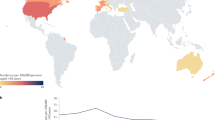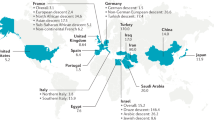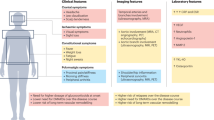Abstract
Giant cell arteritis (GCA, also called temporal arteritis) is a rare and Takayasu arteritis (TA) is an even rarer autoimmune disease (AID), both of which present with inflammatory vasculitis of large and medium size arteries. The risk factors are largely undefined but disease susceptibility has been associated with human leukocyte antigen locus. Population-level familial risk is not known. In the present nation-wide study we describe familial risk for GCA and for GCA and TA with any other AID based on the Swedish hospital diagnoses up to years 2012. Family relationships were obtained from the Multigeneration Register. Familial standardized incidence ratios (SIRs) were calculated for offspring whose parents or siblings were diagnosed with GCA, TA or any other AID. The number of GCA patients in the offspring generation was 4695, compared to 209 TA patients; for both, familial patients accounted for 1% of all patients. The familial risk for GCA was 2.14, 2.40 for women and non-significant for men. GCA was associated with 10 other AIDs and TA was associated with 6 other AIDs; both shared associations with polymyalgia rheumatica and rheumatoid arthritis. The results showed that family history is a risk factor for GCA. Significant familial associations of both GCA and TA with such a number of other AIDs provide evidence for polyautoimmunity among these diseases.
Similar content being viewed by others
Introduction
Giant cell arteritis (GCA, also called temporal arteritis or cranial arteritis), is a systemic inflammatory vasculitis of medium and large arteries, with a possible sequelae of an ischemic optic neuropathy and irreversible or significant visual loss1. Left untreated, it can result in many systemic, neurologic, and vascular complications, including thoracic aortic aneurysms2. Although the temporal artery is most commonly involved, other arteries may also be affected. GCA is commonly associated with polymyalgia rheumatica1. The disease usually occurs at age over 50 years, and women are more commonly affected compared to men2. The prevalence in USA is estimated at 30/100,0003. Although the exact etiology of GCA is unknown, various genetic, environmental, and autoimmune etiologies have been hypothesized4. GCA is a disease of cell-mediated immunity, and the pathophysiology involves activation of adventitial dendritic cells via Toll-like receptors (TLRs) 2 and 4. These in turn activate the differentiation and recruitment of T cells, which produce interferon gamma, a key driver of vascular inflammation and hyperplasia in GCA2. Genetic studies have demonstrated that GCA is associated with the human leukocyte antigen (HLA) class II molecules4. Associations with other suggested genes include intercellular adhesion molecule (ICAM)-1, a chemokine ligand CCL5 (RANTES), and interleukin (IL) 1 receptor4.
Takayasu disease (TA) is another vasculitis of medium and large-sized arteries. TA progresses in two phases, in the first systemic phase, patients present with symptoms of active inflammation while the second phase is the occlusive phase, which presents with symptoms of stenosis in affected arteries. These may include claudication of the muscle groups receiving blood from the affected vessels2. Thoracic aortic aneurysms may be a serious complication also in TA. TA typically presents in female patients younger than 40 years. The prevalence in USA is estimated at 0.3/100,000, thus 1/100 of that of GCA3. The pathophysiological mechanisms in TA are similar to GCA4. Genetic associations for TA have been shown with HLA loci and IL12B4.
We were not able to find studies reporting on familial clustering of GCA or TA. Instead, there is the well-known co-morbidity of GCA with polymyalgia rheumatica; 40–60% of patients with GCA have polymyalgia rheumatica while 16–21% of patients with polymyalgia rheumatica have GCA5. Ulcerative colitis has been described as a co-morbidity in TA6.
Here we provide a detailed assessment of familial risks for GCA and TA based on Swedish hospital records. A concordant familial risk was calculated for both of these diseases and a discordant risk was calculated between these diseases and any other of 41 AIDs.
Results
A total of 769,991 patients with any of 43 AIDs have been identified, of which 51% were received from the Inpatient Register and 49% from the Outpatient Register (see “Methods” section). By the end of the follow-up in year 2012 the offspring generation reached age 80 years. There was no age limits for the parental generation. The dataset contained a total number of 4695 GCA patients in the offspring generation (to whom risks were calculated) with a corresponding mean diagnostic age (i.e., first hospital contact) of 64.3 years. Taking their parents into account the total number of individuals resulted in 12,882 of which 28.5% were males. Overall, offspring with GCA had 52 (1.1%) first-degree relatives (parents or siblings) that were also diagnosed with GCA. The number of affected offspring for TA was 209 (mean diagnostic age 44.5 years) and the total number of patients with TA was 346. About 17.7% of all TA patients were males. Only 2 (1.0%) first-degree relatives were diagnosed with TA. The AID population in total amounted to 519,180 patients in the offspring generation of 8.517 million individuals.
Concordant familial risks
Familial risks for GCA are shown in Table 1 for offspring whose first-degree relatives (parents or siblings) were diagnosed with GCA. The overall familial risks for GCA was 2.14 and only the female SIR of 2.40 was significant. The SIRs were practically equal when parents (2.04) of siblings (1.94) were probands. For TA the risk for offspring of affected parents was 196 (95% CI 18–721), but only based on 2 cases; data not shown. Spousal familial risks were calculated for a husband given a concordant GCA in the wife; the SIR of 1.39 was not significant. No concordant spouses with TA were found.
Discordant familial risks
We analyzed familial risks between GCA or TA and all 41 other AIDs and the significant discordant associations are shown in Table 2. For GCA, associations with 10 AIDs were significant when considering even sex-specific results. Significant bidirectional associations (combined sexes) were noted with polymyalgia rheumatica (SIR for GCA 1.84, reverse 1.72), psoriasis (1.29/1.20), rheumatoid arthritis (1.34/1.27) and Sjögren syndrome (1.87/1.69). Considering the female excess in overall case numbers, many more female associations were consequently significant compared to male associations. TA showed a significant association with 6 AIDs, of which that with rheumatoid arthritis (2.04/2.76) was bidirectional. Both GCA and TA were associated with polymyalgia rheumatica and rheumatoid arthritis. The significant discordant associations are summarized in Fig. 1. Only one family had members diagnosed with both GCA and TA (SIR for GCA 2.28, 0.0–8.92; SIR for TA 1.13, 0.0–4.42).
Discussion
To our knowledge this is the first family study on GCA and TA, which were earlier falsely considered to be the same disease of inflammatory vasculitis of large and medium size arteries, in spite of the different age distributions2. The present results showed that the familial clustering of GCA and TA is rare, as only 1% of the patients had a concordant family history. The familial risk for GCA was 2.14 and it was only significant for women (2.40), which is noteworthy considering the sex difference in incidence. In diseases with large sex differences, stronger familial effect may be found in the gender of lower background incidence, which is referred to as “the Carter effect”, described for pyloric stenosis7,8.
There was no difference in risk when the analysis was done between offspring and parent or between siblings. A higher sibling risk might indicate recessive inheritance or influence of environmental sharing in the childhood. Thus, the present results gave no indication for such contributions. Lacking spouse correlation suggested that even adult environmental sharing played no major role for GCA susceptibility. The familial risk for TA was very high (SIR 196) but as it was based on only 2 cases, it needs to be confirmed with larger case numbers.
In spite of the rare concordant familial clustering, there were 10 discordant associations for GCA and 6 for TA. For GCA, SIRs were about 1.8 with polymyalgia rheumatic and 2.0 with primary biliary cirrhosis, i.e., not much lower than the concordant SIR, which suggests extensive genetic (or environmental) sharing between GCA and these AIDs. Risks were also high for associations with Sjögren syndrome and systemic sclerosis. For TA only rheumatoid arthritis showed bidirectional associations but these were nominally higher than those with GCA. The two vasculitis were both associated with rheumatoid arthritis and polymyalgia rheumatica; the latter association for GCA was not unexpected because of the known co-morbidity. Ulcerative colitis has been described as a co-morbidity for TA, and we found an association of ulcerative colitis in families of GCA6. In spite of the shared clinical features and pathophysiology, GCA and TA were not associated with each other which is probably due to the rarity of familial clustering of these diseases; only one family was found with a patients with GCA and another with TA4. Polyautoimmunity (i.e. presentation of more than one AID in the same individual) is a common feature of many AIDs, and often include thyroid AIDs and type 1 diabetes, both of which manifested also in the present study. The genetic basis of such pleiotropy is partially understood (1, 4); genome-wide association studies have shown that low-penetrance loci are extensively shared between AIDs9,10,11. In a study of pediatric AIDs over 70% of the significant genetic loci were shared by at least 3 AIDs12. The HLA locus is involved in many AIDs, including GCA and TA4. The present data provide strong evidence for polyautoimmunity for GCA and TA, and should call for further characterization of the shared genetic loci.
Limitations of the study are inherent to the rarity of these diseases, particularly TA with in total 346 nationally identified patients. In addition, drastically different age distributions of these vasculitis complicate comparisons between the two. Another problem is also inherent to these diseases, i.e., the co-morbidity of GCA with polymyalgia rheumatica. Our sampling strategy defined inclusion of patients by the first AID diagnosis only. Thus, patients were defined as polymyalgia rheumatica patients even though they might have been diagnosed shortly afterwards with GCA.
In conclusion, the present study provided novel familial risk estimates for GCA and identified discordant associations for GCA with 10 other AIDs and for TA with 6 other AIDs. Significant familial associations with so many other AIDs provide evidence for polyautoimmunity among these diseases.
Methods
Methods used were in principle similar to those in our previous family studies on cancer and autoimmune diseases13,14,15. We identified AID patients from the Swedish Hospital Discharge Register (years 1964 through 2012, full national coverage from 1986 onwards) and the Outpatient Register (2001 through 2012). Only the first AID diagnosis was included. Various revisions of the International Classification of Diseases (ICD) codes were used for identification of AIDs as described elsewhere14. Family relationships were obtained from the Multigeneration Register, containing the Swedish population in families and covering parental generations for a century16. As family members, only first-degree relatives of offspring-parent pairs and siblings were considered; ‘the offspring generation’ was born after 1931 and siblings could be defined only in this generation; ‘the parental generation’ was born any time earlier. Information from the registers was linked at the individual level via the national 10-digit civic registration number. In the linked dataset, civic registration numbers were replaced with serial numbers to ensure the anonymity of all individuals. Spouses were identified through the first common child.
Standardized incidence ratios (SIRs) were calculated for the offspring generation as the ratio of observed to expected number of cases. The expected numbers were calculated for all individuals without a first-degree family history of a specific AID, and the rates were standardized by 5-year-age, gender, period (5 years group), socioeconomic status and residential area. The 95% confidence interval (95% CI) of the SIR was calculated assuming a Poisson distribution. Separate SIRs were calculated for offspring when only parents or only siblings were probands, i.e., they were diagnosed with concordant AID15. In analysis of discordant AIDs bidirectional (i.e., GCA-AIDx and AIDx-GCA) associations were considered.
Ethics
The guidelines of the Helsinki Declaration were followed. The study was approved by the Regional Ethical Review Board in Lund—the so called “Regionala Etikprövningsnämnden i Lund”. The study was conducted in accordance with the approved guidelines with explicit statement that no informed consent was required, because the study is a national register-based study on anonymous personal data. Therefore, the ethical committee “Regionala Etikprövningsnämnden i Lund” waived the need of informed consent.
References
Ameer, M. A., Peterfy, R. J., Bansal, P. & Khazaeni, B. StatPearls (StatPearls Publishing, Treasure Island, 2020).
Harky, A., Fok, M., Howard, C. & Bashir, M. Current controversies in large-vessel inflammatory vasculitis and thoracic aortic aneurysm disease. Int. J. Angiol. 28, 215–225. https://doi.org/10.1055/s-0039-1692448 (2019).
Hayter, S. M. & Cook, M. C. Updated assessment of the prevalence, spectrum and case definition of autoimmune disease. Autoimmunol. Rev. 11, 754–765. https://doi.org/10.1016/j.autrev.2012.02.001 (2012).
Harky, A., Fok, M., Balmforth, D. & Bashir, M. Pathogenesis of large vessel vasculitis: implications for disease classification and future therapies. Vasc. Med. 24, 79–88. https://doi.org/10.1177/1358863x18802989 (2019).
Kermani, T. A. & Warrington, K. J. Polymyalgia rheumatica. Lancet (London, England) 381, 63–72. https://doi.org/10.1016/s0140-6736(12)60680-1 (2013).
Terao, C. et al. Takayasu arteritis and ulcerative colitis: high rate of co-occurrence and genetic overlap. Arthritis Rheumatol. (Hoboken, N.J.) 67, 2226–2232. https://doi.org/10.1002/art.39157 (2015).
Carter, C. The inheritance of congenital pyloric stenosis. BR Med. Bull. 17, 251–254 (1961).
Vogel, F. & Motulsky, A. Human Genetics: Problems and Approaches (Springer, Berlin, 1996).
Hwangbo, Y. & Park, Y. J. Genome-wide association studies of autoimmune thyroid diseases, thyroid function, and thyroid cancer. Endocrinol. Metab. (Seoul) 33, 175–184. https://doi.org/10.3803/EnM.2018.33.2.175 (2018).
Ramos, P. S. et al. A comprehensive analysis of shared loci between systemic lupus erythematosus (SLE) and sixteen autoimmune diseases reveals limited genetic overlap. PLoS Genet. 7, e1002406. https://doi.org/10.1371/journal.pgen.1002406 (2011).
Tajuddin, S. M. et al. Large-scale exome-wide association analysis identifies loci for white blood cell traits and pleiotropy with immune-mediated diseases. Am. J. Hum. Genet. 99, 22–39. https://doi.org/10.1016/j.ajhg.2016.05.003 (2016).
Li, Y. R. et al. Meta-analysis of shared genetic architecture across ten pediatric autoimmune diseases. Nat. Med. 21, 1018–1027. https://doi.org/10.1038/nm.3933 (2015).
Chattopadhyay, S. et al. Influence of family history on risk of second primary cancers and survival in patients with squamous cell skin cancer. Br. J. Dermatol. https://doi.org/10.1111/bjd.18809 (2019).
Hemminki, K., Forsti, A., Sundquist, K., Sundquist, J. & Li, X. Familial associations of monoclonal gammopathy of unknown significance with autoimmune diseases. Leukemia 30, 1766–1769. https://doi.org/10.1038/leu.2016.43 (2016).
Thomsen, H. et al. Familial risks between Graves disease and Hashimoto thyroiditis and other autoimmune diseases in the population of Sweden. J. Transl. Autoimmunity 3, 1–5. https://doi.org/10.1016/j.jtauto.2020.100058 (2020).
Hemminki, K., Ji, J., Brandt, A., Mousavi, S. M. & Sundquist, J. The Swedish family-cancer database 2009: prospects for histology-specific and immigrant studies. Int. J. Cancer 126, 2259–2267. https://doi.org/10.1002/ijc.24795 (2010).
Acknowledgements
The study was supported by the European Union’s Horizon 2020 research and innovation programme, Grant No 856620.
Funding
Open Access funding enabled and organized by Projekt DEAL.
Author information
Authors and Affiliations
Contributions
The overall study was conceived by K.H., X.L. and H.T.; acquisition of data was performed by J.S. and K.S.; statistical analysis and interpretation was done by X.L., H.T. and K.H.; K.H., A.F. and H.T. wrote the manuscript. All authors edited the manuscript.
Corresponding author
Ethics declarations
Competing interests
The authors declare no competing interests.
Additional information
Publisher's note
Springer Nature remains neutral with regard to jurisdictional claims in published maps and institutional affiliations.
Rights and permissions
Open Access This article is licensed under a Creative Commons Attribution 4.0 International License, which permits use, sharing, adaptation, distribution and reproduction in any medium or format, as long as you give appropriate credit to the original author(s) and the source, provide a link to the Creative Commons licence, and indicate if changes were made. The images or other third party material in this article are included in the article's Creative Commons licence, unless indicated otherwise in a credit line to the material. If material is not included in the article's Creative Commons licence and your intended use is not permitted by statutory regulation or exceeds the permitted use, you will need to obtain permission directly from the copyright holder. To view a copy of this licence, visit http://creativecommons.org/licenses/by/4.0/.
About this article
Cite this article
Thomsen, H., Li, X., Sundquist, K. et al. Familial risks between giant cell arteritis and Takayasu arteritis and other autoimmune diseases in the population of Sweden. Sci Rep 10, 20887 (2020). https://doi.org/10.1038/s41598-020-77857-7
Received:
Accepted:
Published:
DOI: https://doi.org/10.1038/s41598-020-77857-7
This article is cited by
-
Application progress of multiple imaging modalities in Takayasu arteritis
The International Journal of Cardiovascular Imaging (2021)
Comments
By submitting a comment you agree to abide by our Terms and Community Guidelines. If you find something abusive or that does not comply with our terms or guidelines please flag it as inappropriate.




